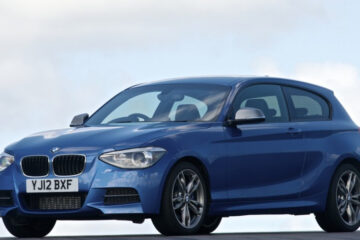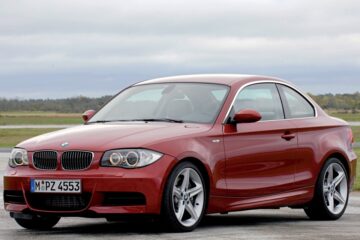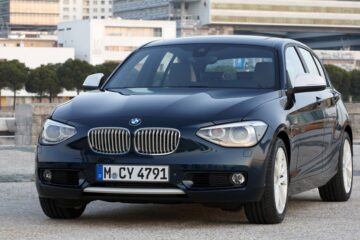In 2004, the BMW concern showed the car with the E87 body to the general public. Three years later, the five-door hatchback was restyled. At the same time another version of the car, E81, appeared. It was presented at the Geneva Motor Show. All who were familiar with the first car, could ask the question, and what is it? Because BMW 1 series cars have almost the same characteristics. In fact, the three-door hatchback was a copy of the five-door, a kind of improved version. Only it weighed 10 kg lighter. Therefore, these models often go in the designation together, BMW 1 E81/E87.
Because of this, we will not detail below the exterior of the car, its interior, the presence of electronics, technical specifications and the engines used. They are, practically, identical with the BMW E87 (here you can put a link to the page). Therefore, we will point out only important nuances, see how the BMW 1 Series E81 differs from the body with the index 87, and then compare it with competitors from other manufacturers.
Important nuances
BMW 1 Series E81 is equipped with six (3 – gasoline, 3 – diesel) engines, the volume of which is 1995 cm3. The power of power units varies in the range of 122-204 “horses”, fuel consumption – in the range of 4-12.2 liters / 100 km. Acceleration to “one hundred” is 6-10.2 seconds, the top speed is 204-238 km/h. BMW 116i E81 and 116d models have the worst performance in the last two points.
As standard, all models except the 130i are powered by a GS6-17DG six-speed manual. But if the customer wishes, a six-range automatic transmission, the GA6HP19 ZF, can be fitted.
The gasoline units use the Valvetronic system (changes the valve lift height) and employ Double Vanos valve technology. Diesel units incorporate a BER system with an automatic Start/Stop button. It utilizes braking energy by regenerating it.
Interior
The interior of the BMW E81 is designed in the same style as the E87. Only the doors are frameless and larger in size, reminiscent of coupe versions. The configuration can be four/five-seat. In the first variant, the 2nd row passengers will be separated by a compartment designed for small items. A little above it was said that the E81 has lost 10 kg in weight, but its dimensions, compared to the five-door hatchback have not changed. I.e. for people in the 2nd row nothing has changed! However, wide doors made it easier to get in/out from the first row. Thanks to the increased area of glazing, visibility has also improved. There are no major changes in the interior, but the exterior has been slightly modernized. The shape of bi-xenon headlights has changed, their edging has darkened. The three-door model has a decorative overlay, its spoiler edge has been strengthened, and the air intake has become slightly wider.
Equipment
For the first time, the E81 features a state-of-the-art Brake Energy Recovery (BER) system. This system saves fuel. Using intelligent control (IAC), the system recycles lost energy. The result is minimized drag on the powertrain and recharges the battery if necessary.
Note that to save fuel, different innovations were used.
The Start-Stop button is used for automatic engine shutdown, which the driver can easily disable. Its principle of operation is as follows. It will turn off the power plant when the hatchback is not moving and the E81 is put in “neutral”. It is enough for the driver to press the clutch to start the engine. With electric power steering, more (90%) energy can be saved than with conventional power steering. The steering wheel is assisted when turning by an electric motor, running when required.
The situation is similar in the auxiliary elements. For example, power to the air conditioner, 1-zone or 2-zone, is switched on/off from the transmission, depending on whether it is in use or not. When the powertrain needs less air, the flaps behind the radiator grille automatically close. This improves aerodynamic efficiency and engine starting in winter. The car has an excellent safety record. There are six airbags. Suffice it to say that, like the E87, it has a Euro NCAP safety rating of 33 on a maximum scale of 37 points!
The Dynamic Stability Control (DSC) system provides additional safety and comfort. The PDC system has also been implemented, which allows the BMW driver to avoid collisions with other vehicles. In case of a dangerous approach, it will give an audible signal. The emergency proximity warning system is particularly important when parking.
Difference between restyling and prerestyling
A slight restyling has enlarged the front grille and lower spoiler of the car. This was done to give the air flow better accessibility to the powertrain. The changes at the rear involved the bumper and the lights. The restyling of the first element gave the car a sportier look, because it appeared wider and lower. Headlights, without changing the original shape, received a new arrangement of lights. In 2012. BMW 120i E81 and BMW 118i E81 and other 1-series models gave way to the 2nd generation BMW F21.
Competitors
The BMW E81 or E87, judging by the reviews of car owners, has many competitors. Let’s dwell on three cars. We will tell you a little about two of them, but we will dwell on the third one longer.
The Swedish company has a great alternative to the hatchback from BMW in its lineup. This is the V40 model. This is a practical, stylish and beautiful car with a coupe-like shape. If you do not want a “Bavarian”, Volvo will be a good choice. The second competitor is from Germany. This is an A-class car with a luxurious interior finish from the famous Mercedes. For a little money, the buyer gets a full-fledged hatchback, an economical and high-quality car, if BMW did not please him in some way.
But, perhaps, the main competitor of the E81 is the A3 model from Audi. It is the company’s premium hatchback and resembles the Volkswagen Golf in terms of technical equipment. However, the A3 is more expensive, because new technologies have been introduced and it has a more expensive finish. Audi’s option is the Quattro all-wheel drive system. BMW’s is the xDrive system. In contrast to the iDrive system in BMW Audi equips the “three” with MMI. Infotainment systems do not differ in comfort and quality. The interior of the A3 feels designer minimalism, but the quality of finishing is high. Every element is where you would want it to be. The 7-inch display, the aforementioned MMI system, pops up from a panel that merged the audio and climate control controls. The front seats are comfortable and the ergonomics are top notch.
In the cabin of E81 everything is good too. True, the display size is smaller (6.5 inches) and it is attached to the top of the panel. However, its graphics and resolution are more winning. Driver and front passenger seat adjustment and lumbar support are available in both cars. The BMW’s driver’s seat has a higher seating position, improving visibility, but the A3 has more vertical adjustment ranges. For the driver’s car seat, there are comfortable conditions in both models. On a good road, the E81 has the advantage, but the A3 is more pleasant to overcome bumps. Audi’s suspensions are more long-walking and smoothness of a course is better, than in more rigid “Bavarian”, which has independent spring suspension in front and behind. Small potholes A3 overcomes without lurching and rocking, but E81 suffers from longitudinal rocking.
In engine noise, the BMW has a complete advantage. There’s nothing to compare.
Hatchbacks are compact, so there is no excess space in the rear. There is equality here, 7-10 cm to the front backrest. There are no cupholders/folding armrest, and the E81 has no door pockets. Trunk volumes are about the same. The 20 liter advantage of the A3 does not give anything. Because Audi has a spare in the trunk, and BMW doesn’t, because it has self-supporting ZP tires, which allow to move even if there is no pressure in them!
And a little bit about the electronics and navigation system.
Both cars can be fitted with Drivenge cruise control with speed limiter, as well as a rain and light sensor. Owners of both vehicles do not have to manually clean the headlights because the models have headlight washers.
The E81’s OEM navigation suggests:
- 8.8-inch monitor;
- 8GB Hard-disk;
- Built-in 3D navigation;
- Ability to connect a TV tuner;
- Supports Bluetooth cell phones and MP3/WMA/DVD format.
The A3 has navigation support:
- Analog TV tuner;
- Bluetooth;
- Four channels of audio (24-bit) at 45 watts each.
The E81 has the Comfort Access system (you can lock/unlock the hatchback without actively using the ID transmitter). Audi has it in A4 models. As you can see, no one has special advantages. A3 is stronger in one component, E81 is stronger in another.
Troubleshooting E81
Now a little bit about the “Bavarian” sore spots. Let’s analyze the typical faults of the car.
Creaks may be emitted from the front panel. The problem is less frequent after tuning. Side mirrors may unscrew when unfolding. It is necessary to disassemble the mirror and to clean the oxidized locking mechanism. If you notice water in the cabin after prolonged rains, it means that the noise insulation inside the doors has peeled off. Power failures can lead to electrical problems. Oxidation/rotting of the plus wire terminal under the floor will cause the cooling fans to stop turning on and the power to the fuse box to start failing.
After 70-100 thousand miles, the ELV electric steering lock may fail. As a result, the engine will not start and the steering wheel is locked. After 200 – the efficiency of the heating system may decrease. This means that the auxiliary pump has given up. Typical malfunctions include the failure of the FRM block, which is responsible for the exterior lighting and the operation of the central locking system. What is good, the E81 has a self-diagnostic system CBS. What is this in an automobile? It monitors all the necessary timelines on various parts of the car and alerts the driver when maintenance is required.
Generations and configurations
1 generation – restyling
05.2007 – 08.2012
| 116i MT Base | N45B16 | 1.6L | 116 hp |
| 116i AT Base | N45B16 | 1.6L | 116 hp |
| 118i MT Base | N46B20 | 2.0L | 136 hp |
| 118i AT Base | N46B20 | 2.0L | 136 hp |
| 120i MT Base | N46B20 | 2.0L | 156 hp |
| 120i AT Base | N46B20 | 2.0L | 156 hp |
| 120d MT Base | N47D20 | 2.0L | 177 hp |
| 120d AT Base | N47D20 | 2.0L | 177 hp |
| 123d MT Base | N47D20 | 2.0L | 204 hp |
| 123d AT Base | N47D20 | 2.0L | 204 hp |
| 130i MT Base | N52B30 | 3.0L | 265 hp |
| 130i AT Base | N52B30 | 3.0L | 265 hp |



0 Comments